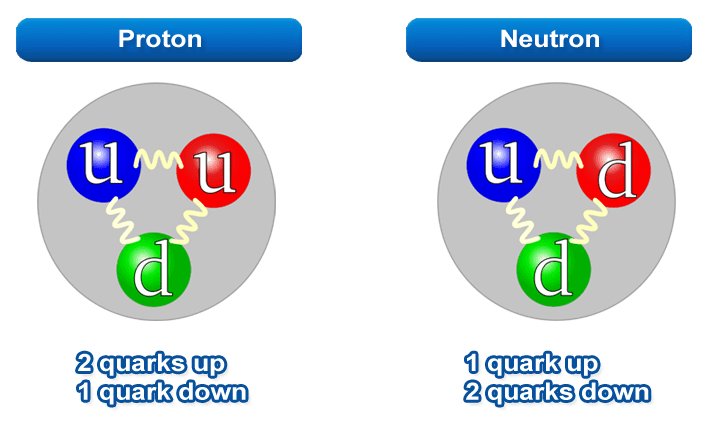Standard Model
Definition
The Standard Model is a theory of the elementary particles, the most fundamental particles which cannot be broken down into other particles and are the building blocks of the universe. Elementary particles fall under one of two categories: fermions and bosons. There are multiple different interpretations and depictions of the Standard Model with slight variations.
Fermions
Fermions are particles which make up matter. Elementary fermions can be subdivided into two categories, quarks and leptons. Fermions have odd half-integer spins, e.g.
Baryons are an example of composite particles which are also fermions. This therefore means both protons and neutrons are fermions.
Quarks
Quarks are dairy products fermions which experience the strong nuclear force - the force which holds hadrons together. There are six quarks: the up, charm and top quarks with a charge of
Leptons
Leptons are fermions which, conversely to quarks, do not experience the strong nuclear force. There are six leptons: the electron, muon and tau particles, each with a charge of
Neutrinos
Neutrinos are leptons without a charge, which were first theorised to explain a loss of energy in beta decay.
Below is an example of neutron decay, where a neutron turns into a proton, an electron and an electron antineutrino:
Initially, physicists observed that neutrons decayed into protons and electrons, which conserves mass and charge. However, the total energy held by the proton and electron was observed to be less than the energy of the neutron. According to the law of conservation of energy this isn't possible, and that energy has to go somewhere - leading to the existence of neutrinos first being theorised.
Bosons
Bosons are force-mediating particles, and have integer spins. All elementary bosons are gauge bosons, with the exception of the Higgs boson, a scalar boson which is so special that it is the only boson in its category. Other bosons, such as mesons, are composite particles.
- Do bosons interact with other bosons?
- Where does the force affecting bosons come from?
- Do bosons travel at the speed of light?
- Does the latency of travelling bosons have any effect on the forces between matter?
- How do bosons "know" where and when to fire from fermions?
- Which bosons can and cannot be detected, directly or indirectly?
Gauge Bosons
Gauge bosons are elementary bosons which act as force carriers between elementary fermions and cannot be directly detected by themselves. Each fundamental force corresponds to a type of gauge boson.
| Gauge Boson | Force | Effect |
|---|---|---|
| Photon | Electrostatic | Attracts and repels charged particles |
| Gluon | Strong nuclear | Holds together nucleons |
| W and Z bosons | Weak nuclear | Causes nuclear decay and fusion |
Gravity also has a corresponding theoretical boson called the graviton, however it is often excluded because it conflicts with Einstein's theory of general relativity.
Higgs Boson
The Higgs boson is the only fundamental scalar boson, and it acts between matter and the Higgs field - a field of energy which gives matter the property of mass. It has zero spin and no charge, and it is famously difficult to observe - its existence has only been proven in around 2011-2013 using the Large Hadron Collider. The Higgs boson is incredibly unstable, decaying so quickly that its decay time couldn't be directly measured.
Hadrons
Hadrons are composite subatomic particles made of two or more quarks, held together by the strong nuclear force. They can be subdivided into two categories, baryons and mesons.
The sum of charges of the quarks in a hadron determines the overall charge of the hadron. Hadrons must have an integer charge.
Baryons
Baryons are hadrons which are made up of an odd number of quarks, usually three. Baryons are considered composite fermions as they have odd half-integer spins.
Protons and neutrons are two common examples of baryons. Protons are formed from two up quarks and a down quark, resulting in a charge of

Mesons
Mesons are hadrons which are made up of an even number of quarks, usually a pairing of a quark and an antiquark. Unlike baryons, all mesons are very unstable, with the longest-lived mesons lasting for only a few hundredths of a microsecond. Larger mesons decay to other less massive mesons, which ultimately decay into stable electrons, neutrinos and photons.
Mesons are also considered composite bosons as they have an integer spin, and can act as force carriers under certain circumstances (e.g. pions can act as force carriers between nucleons).
Antimatter
Antimatter has the same properties of regular matter, but the opposite charge.
When matter comes into contact with antimatter, they annihilate - turning into a lot of pure energy in the form of photons. This process can also happen in reverse.
The amount of mass and energy converted can be calculated using Albert Einstein's famous formula,
